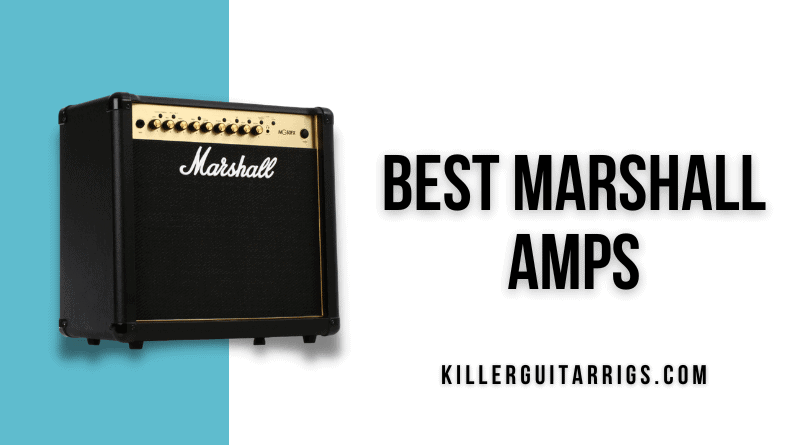It’s hard to think of a brand that represents rock and roll’s history better than Marshall. Their tone, features, and quality paved the way for some of the most iconic rock records of all time, and their impressive double-stack setups have graced the concert stages of the greatest guitar heroes we all know and love.
It all started with a British man named Jim Marshall, who had a vision and started the company in the 60s. Today, Marshall is still heralded as one of the greatest amplifier companies in the world, and they have continued to produce amps that adjust to today’s player.
After all, the classic Marshall sound is still pursued by many guitarists. The company knows this and has increased its models and lines of amps significantly in the last two decades.
With so many options, how do you make sense of it all? We’re here to help. Keep reading.
Read more about our review process.
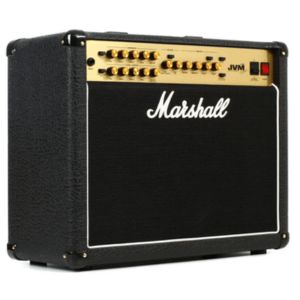
Marshall JVM215C
Features: Studio quality digital reverb, Speaker-emulated XLR line-out, Clean/crunch and overdrive channels
Benefits: High end build quality, Pro grade tones, Incredible power
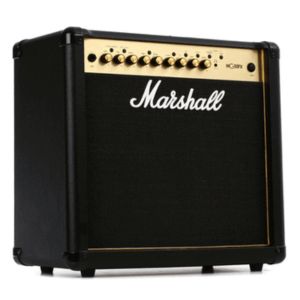
Marshall MG50GFX
Features: 50 Watts of power, Built in FX, 2 Button footswitch included
Benefits: Convincing tube tone, Easy sound shaping, Classic British sound
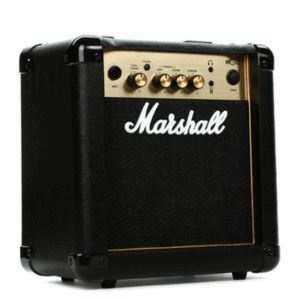
Marshall MG10G
Features: 10.5lbs Weight, Custom 6.5" speaker, 1/8" Aux input
Benefits: Excellent practice amp, Genuine Marshall tone, Extremely portable
Contents
Our Top 3
The Marshall MG50GFX is our Top Choice for this list. This combo amp delivers an ideal balance between power, convenience, and features, with 50 watts of power on a 1 X 12″ configuration that delivers legendary British tone.
The Marshall MG10G is our Budget Choice. This ultra-convenient amplifier gives you 10 watts of power on a custom 6.5″ speaker, making it ideal for practicing and for beginners. It features a Clean and Overdrive channel as well as a Contour control at an affordable price.
The Marshall JVM215C is our Editor’s Choice. With an all-tube design that includes five 12AX7s and two EL34s, you get two channels and three foot-switchable modes for greater flexibility. This is a great choice for discerning players.
Individual Reviews

Marshall MG50GFX
An ideal blend of power and flexibility.
This combo amp strikes the perfect balance between power, convenience and features, giving you a gigging musician's tool that can last you for years. With iconic Marshall tone and vibe, this amp delivers on the promise of good tone from one of the most revered amplifier brands in history.
The Marshall MG50GFX gives you 50 watts of power on a 1 X 12″ configuration with a Custom 12 speaker on a design that delivers legendary British tone.
This amplifier offers great versatility as it offers four channels labeled Clean, Crunch, OD1, and OD2. These operate on two channels per button. In other words, you have to pick between Clean or Crunch on button one and OD1 or OD2 on button two.
A simple 3-band EQ provides easy and convenient tone shaping, and you also get delay, reverb, and digital effects for added flexibility. If you dial a tone you fall in love with, this Marshall gives you preset channel modes that allow you to store and recall your settings at will.
For our test (check out our full MG50GFX review here), we used our Strat going directly into the amp. We quickly realized that this amp is loud, but it also gave us a nice tone at lower volume settings. All four available channels have their own voices, but we particularly liked OD1.
Here, we got a warm overdrive that was perfect for bluesy solos on the fourth position on our Strat. We added a bit of reverb and went to the Tape Delay setting on the delay knob for a tone with nice sustain and warmth.
We also liked the clean channel, especially with a touch of reverb. On the effects knob, we dialed a bit of chorus that worked great for some nice open chord parts. This knob also offers phaser and flanger, making this amp versatile.
We also loved the emulated headphone output, which allowed us to play silently while still keeping our settings and tone, making it ideal for practicing. In short, a nice amp that can be used for gigging and practicing with Marshall quality.
Verdict: The Marshall MG50GFX is a combo amp that offers 50 watts of power on a Custom 12 speaker. It comes with four distinct voices, as well as reverb, digital effects, and speaker-emulated headphone outputs.
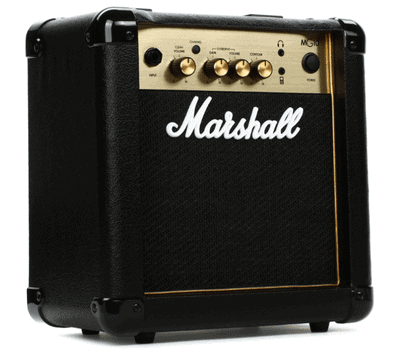
Marshall MG10G
A compact format amp that packs a punch.
This amp comes at a little size but retains the vibe, quality and overall tonal character that Marshall is renowned for. Perfect for practicing, this amplifier offers more than meets the eye.
The Marshall MG10G is an ultra-convenient 10-watt combo amp with a custom 6.5″ speaker, perfect for practicing. You get British tone on a Clean and Overdrive channel as well as a Contour control that allows you to shape your tone.
You can choose to practice using this unit as a combo or through its 1/8″ output for headphones for working on your chops in silence. The headphone-out also doubles as a speaker-emulated Line Out so you can go directly into a PA or to your recording interface for tracking.
In case you want to play along with some tracks, the MG10G also features a 1/8″ Aux in to plug a phone or tablet. You’ll need to buy a separate 1/8″ cable for this, but it will be well worth it.
For our tests, we tried this amp with our Fender Strat. It sounds good for such a small amp (the reason we included it in our roundup of the best small amps), and that is true for both channels. We got a nice clean tone on the Clean channel with the Contour knob dialed in at about 3 o’clock and the Strat on the fourth pickup position.
For the Overdrive channel, we preferred to set the contour knob at around noon and our Strat on the second pickup position. We got a nice overdrive with the Gain at around 10 o’clock and a punchy tone with some aggression with the Gain at 3 o’clock.
With the Gain at around noon, we got a nice bite for such a little amp. It worked well for rock and blues solos and sounded just as good once we plugged our headphones into the 1/8″ out.
In short, a nice practice amp that is simple, easy to use, and convenient. This is a great choice for beginners looking for a good-sounding and practical first amp.
Verdict: The Marshall MG10G gives you 10 watts on a custom 6.5″ speaker as well as a Clean and Overdrive channel. With a contour knob and headphone output for silent practice, this is a great choice for beginners.
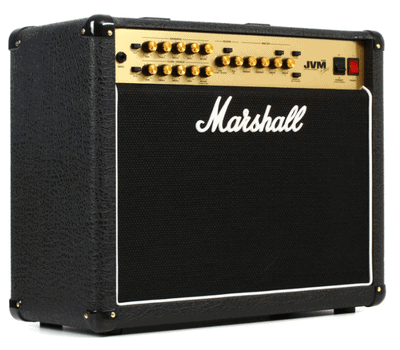
Marshall JVM215C
A powerful and well-designed amp for the discerning guitarist.
A simple yet versatile design with authentic tube tone. This amp is for folks that want realistic Marshall sound on a one-speaker combo amp configuration.
The Marshall JVM215C features an all-tube design that includes five 12AX7s and two EL34s for that unique British flavor in tone. It comes with two channels, both of which give you three foot-switchable modes for greater flexibility.
Both of these channels have separate knob controls, so you can set each as you like it and flip back and forth at will. These knobs include Gain, Treble, Middle, Bass, and Volume. The reverb section on the amp has two knobs, each for independently controlling each of the channels. Finally, the master section has separate volume controls for each channel for greater tonal independence and flexibility.
We tried this amp with our Gibson Les Paul going direct. We first auditioned the overdrive channel, and it became evident just how powerful this amp is. We got tons of punch with a good dose of clarity for power chords with the Gain knob at around 1 o’clock.
This setting was also great for classic rock riffing, with great string separation and nice bottom end. Pushing the Gain knob all the way to 3 o clock, we got into crunch territory, great for some heavier playing with a tone that was punchy and rich in harmonics.
Other useful features on this amp include two effects loops, one in series, and the other can be either parallel or series and turned on/off via a footswitch. This amp also features a speaker-emulated XLR line-out so you can go directly into your DAW with killer tone and no need to wake up the neighbors.
Moving on to the Clean channel, we got a nice open and forward tone on the bridge pickup. With a bit of reverb, the sound was ideal for playing open arpeggio chords and even some more rhythmic parts. On the neck pickup, we got a warmer tone that would help the guitar blend nicely with a full band.
In short, a fantastic amp for folks who value quality and are willing to pay for it.
Verdict: The Marshall JVM215C features an all-tube design that includes five 12AX7s and two EL34s for that unique British flavor in tone. It comes with two channels, both of which give you three foot-switchable modes for greater flexibility.
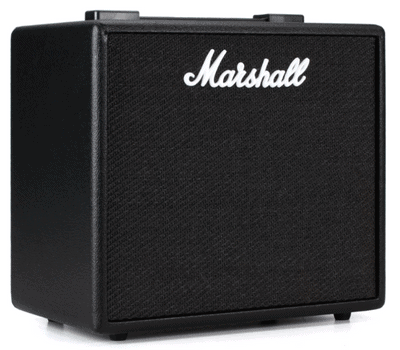
Marshall Code 25
Modeling technology that delivers tone and convenience.
This amp offers tons of sounds and ways to control them, from onboard knobs all the way to control via a mobile app. It is a very convenient amp for practicing, as it gives you plenty of options as well as Bluetooth connectivity for playing along with tracks.
The Marshall Code 25 gives you 25 watts of power and employs modeling technology to offer a combo amp with a 10″ speaker, 14 digital preamp models, and four power amp models. To make it even more comprehensive, Marshall also threw in speaker emulation, onboard effects, an LCD display, one Aux Input, and Bluetooth Connectivity.
In other words, you get a wide array of sounds and tonal possibilities on a very versatile amp. With ultimate convenience in mind, Marshall also opted to include the control panel on the top part of the amp, as opposed to the more traditional front.
We tried this amp with our Fender Strat going in directly. We were a bit impressed by just how many choices this amp gives the user. We auditioned many of its presets and liked how the clean ones sounded the best. Having control over effects like reverb and delay was also very convenient and gave us even more flexibility.
One of our favorite aspects of the Code 25 is Bluetooth Compatibility. We hooked it to our cell phone and started jamming along to some YouTube tracks in an instant. This was truly convenient and a great choice for practicing, as well as for folks who do small solo gigs that require backing tracks.
Naturally, a digital amp at this price point is not going to excel in tone, especially when it comes to distortion and overdrive. That said, this Marshall is a fantastic option for practicing and is especially good for those looking for a first amp.
Verdict: The Marshall Code 25 relies on modeling technology to give you plenty of options on 25 watts of power. With 14 digital preamp models, speaker emulation, and Bluetooth Connectivity, this amp is a true champion of versatility for folks who like to keep it practical.

Marshall 2525H Mini Silver Jubilee Head
A leaner and version of a legendary amp.
The vintage Marshall Silver Jubilee belongs in the pantheon of historic tube amplifiers that defined rock. With an aggressive sound that was prominent in the '80s and early '90s, the original was quite popular among top guitarists. This is a reissue that adds an upgraded performance and reduces its footprint.
The Marshall 2525H Mini Silver Jubilee Head is an improved and smaller version of one of Marshall’s most popular amp heads. This revamped design addresses the issue that although a 100-watt amp sounds great, it is nearly impossible to make it sound as good at reduced levels.
The 2525H puts the Silver Jubilee sound into an amp with a more limited 20 watts of tube power. This gives the user a fantastic amount of power for headroom but does not render the amp nearly useless for quieter performance. For practicing at home, you can now switch the amp to 5-watt mode, which is great for avoiding eviction or divorce.
We were eager to try this amp head out, so we plugged in our Gibson Les Paul into our pedalboard and then into the 2525H, which we plugged into our PPC112 Orange 1×12 cabinet.
We started with the amp head set at 20 watts and some bold distortion dialed in. We got that Silver Jubilee tone from the get-go, aggressive and well-defined, perfect for playing everything from powerful power chords and riffs to soaring leads with great sustain. This was particularly true with our Les Paul on the bridge pickup.
We then dialed the distortion back a bit and went into the neck pickup. Here, we got a warm tone that still had bite but in a very musical way. This was great for some blues-induced soloing, as well as some comping.
When we switched it to 5 Watts, this amp retained its quality and tone, which was quite impressive. This amphead is the real deal. As such, it is not cheap, which may turn off some folks.
Verdict: The Marshall 2525H Mini Silver Jubilee Head is a smaller version of one of Marshall’s most popular amp heads that adjusts for today’s player. With 20 watts of power and the possibility of switching to 20 watts, you can now have the legendary silver jubilee sound for smaller venues and while practicing.
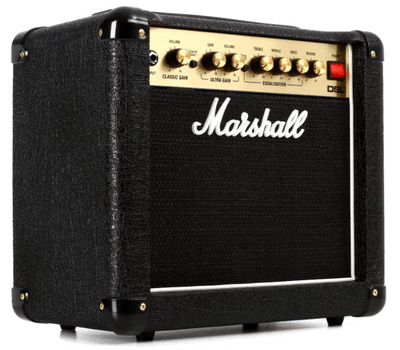
Marshall DSL1CR 1x8"
All tube design and tone on a compact amp.
This amp is capable of producing true Marshall tone on a very compact size. With an all tube design and Marshall vibe and feel, you can now have legendary tone at low volumes.
The Marshall DSL1CR 1×8″ features two channels, labeled Classic Gain and Ultra Gain, respectively, and an 8″ Celestion Eight 15 speaker. This one-watt amp comes with two ECC83 tubes on the preamp and one ECC82 power tube, giving you authentic Marshall tone in a compact unit.
Through a button on the back panel, the user can select between high and low power modes in order to dial the appropriate volume for any situation without losing the character of your tone. Additionally, Marshall teamed up with Softube to create a line output that offers an emulation of a Marshall 1960s cab, ideal for going direct into your DAW.
We tried this amp with our Fender Strat and put a few pedals before, like our Tube Screamer and TC Electronic Hall of Fame Reverb, while the amp was on the Classic Gain channel. The DSL1CR takes pedals well, delivering the true nature of our effects stompboxes at a low volume.
We then tried the Ultra Gain channel by pressing a small button right next to the Classic Gain volume knob. With the gain turned up to the 2 o’clock position, we got aggressive and thunderous distortion for such a little amp. Thanks to the all-tube design, this smaller Marshall delivers a great tone for such a little amp.
In short, a nice-sounding amp that is built with legendary Marshall quality and tone. At this price, however, some may opt for other choices that offer more features.
Verdict: The Marshall DSL1CR 1×8″ gives two channels on a one-watt all-tube design that delivers legendary British tone at low volumes. With two modes of operation for further flexibility on the volume and speaker-emulated output, this amp is a good choice for beginners and folks who want to practice with Marshall tone.
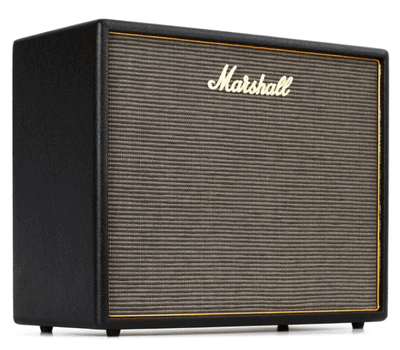
Marshall ORI20C Origin 1x10"
Gritty tone for different uses at all times.
This amp is a great choice for gigging, rehearsing and practicing, all with great tone. It combines the best of the Marshall tradition with some modern appointments, all of it with renowned quality and built.
The Marshall ORI20C Origin 1×10″ features three ECC83 preamp tubes and two EL34 power tubes, with a 10″ Celestion V-type speaker. This is a fantastic combination that provides great tube tone with nice definition (also available in a head – the ORI20h).
In order to appeal to today’s guitar player, Marshall also included switchable low, mid, and high output levels in order to deliver high-output quality at any volume.
We plugged our Gibson Les Paul and set the amp on the mid-output level. With the Gain knob dialed in at six, we got a Plexi-style grind that was exactly what we expected, with fantastic punch for power chords and heavy riffs and a massive lead tone with tons of sustain.
We ran our tests in all three levels of output. The middle one gave us three watts, and the low one about half a watt. Naturally, at half a watt, you lose some of that tone, you get at 20 or even three watts. However, it’s a perfect choice for late-night practice.
We did try the high output for about five minutes before anyone would call the cops on us. Needless to say, the high output was quite loud, perfect for gigs or those rehearsals where you want to match the drummer.
It’s important to point out that the gain boost adds some real fatness to the tone, making this amp very musical and great for blues and heavy rock. In short, it is a fantastic amp for folks who want the Marshall tone for some serious gigging and convenient practicing.
Verdict: The Marshall ORI20C Origin 1×10″ comes with three ECC83 preamp tubes , two EL34 power tubes, and a 10″ Celestion V-type speaker. With three possible output level settings, this amp gives you fantastic tone at any volume while remaining great for both gigging and practicing.
How To Choose The Right Amp For You
Marshall offers a wide variety of types of amps. In this guide, we’ll break it down by some of the most common differences. Consider the following when trying to decide which Marshall amp to buy.
Solid state, modeling and tube amps
The solid-state vs. tube debate is an important consideration when buying an amp. Naturally, tube amps are more traditional, warmer, more dynamic, and respond better to a player’s touch.
The flip side is they are also more expensive, heavier, and far more fragile. On the other hand, solid-state amps tend to be cheaper, lighter, and far more durable as well. The tradeoff is that their tone is not as good, particularly when it comes to distortion.
You should also consider modeling amps. These replicate the sound of particular amps digitally. Although not as organic, you get a broad range of tones, which in turn gives you tons of versatility. This same technology also helps keep costs down, which is arguably one of the biggest reasons to get a modeling amp, particularly if you are a beginner.
Size and power
One of the main factors you should consider when buying an amp is just how much output you need from it. Do you want to use it for live performances? Will you be playing in big or small venues? These questions are important as they will determine how big an amp you get.
For instance, a 100-watt double stack will likely be overkill for playing with a cover rock band at the bar on Friday night. Not to mention, it will be expensive and a massive pain in the rear to transport it, quite literally.
A 50-watt combo amp may do just fine for the situation above. Again, asking yourself what you need the amp for is key.
On the other hand, if you are a student living with your parents or in a dorm, you may want to consider a smaller amp that offers a low-wattage option or even a headphone out.
Price
Price is often one of the main concerns when buying an amp, and rightfully so. In broad terms, a tube amp will cost more than a solid state, and a bigger amp will also be more expensive.
Although known for massive setups and loud volume, Marshall also produces several amp models that are small, convenient, and affordable. Even their solid-state models that offer modeling are a great choice for many.
Final Thoughts
The Marshall brand is one of the most revered when it comes to guitar. From Jimi Hendrix to Eric Johnson, these amps have been widely used by some of the greatest guitar players to ever live.
Marshall continues to produce quality amps today, many of them catered to the needs of today’s guitarists, which include students and folks who want that tone at a much lower volume.
To recap our top choices, The Marshall MG50GFX is our Top Choice as this combo amp delivers an excellent balance between power and convenience, with 50 watts in a 1 X 12″ configuration.
The Marshall MG10G is our Budget Choice. This amp offers 10 watts of power on a custom 6.5″ speaker and is quite compact. Ideal for practicing and for beginners, you get a Clean and Overdrive channel for nice versatility at an affordable price.
The Marshall JVM215C is our Editor’s Choice. This amp features an all-tube design with two channels and three foot-switchable modes for greater flexibility. This is a great choice for tone-savvy guitar players who value quality.

